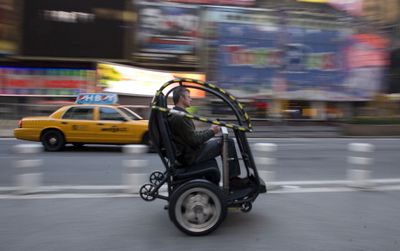GM, Segway think ultrasmall with two-wheeled urban vehicle

NEW YORK – A solution to the world’s urban transportation problems could lie in two wheels not four, according to executives for General Motors Corp. and Segway Inc.
The companies announced Tuesday that they are working together to develop a two-wheeled, two-seat electric vehicle designed to be a fast, safe, inexpensive and clean alternative to traditional cars and trucks for cities across the world.
The Personal Urban Mobility and Accessibility, or PUMA, project also would involve a vast communications network that would allow vehicles to interact with each other, regulate the flow of traffic and prevent crashes from happening.
“We’re excited about doing more with less,” said Jim Norrod, chief executive of Segway, the Bedford, N.H.-based maker of electric scooters. “Less emissions, less dependability on foreign oil and less space.”
The 300-pound prototype runs on a lithium-ion battery and uses Segway’s characteristic two-wheel balancing technology, along with dual electric motors. It’s designed to reach speeds of up to 35 miles per hour and can run 35 miles on a single charge.
The companies did not release a projected cost for the vehicle, but said ideally its total operating cost – including purchase price, insurance, maintenance and fuel – would total between one-fourth and one-third that of the average traditional vehicle.
Larry Burns, GM’s vice president of research and development, and strategic planning, said the project is part of GM’s effort to remake itself as a purveyor of fuel-efficient vehicles. If Hummer took GM to the large-vehicle extreme, Burns said, the PUMA takes GM to the other.
Though the technology and its goals may seem like something out of science fiction, Burns said nothing new needs to be invented for it to become a reality.
“At this point, it’s merely a business decision,” he said.